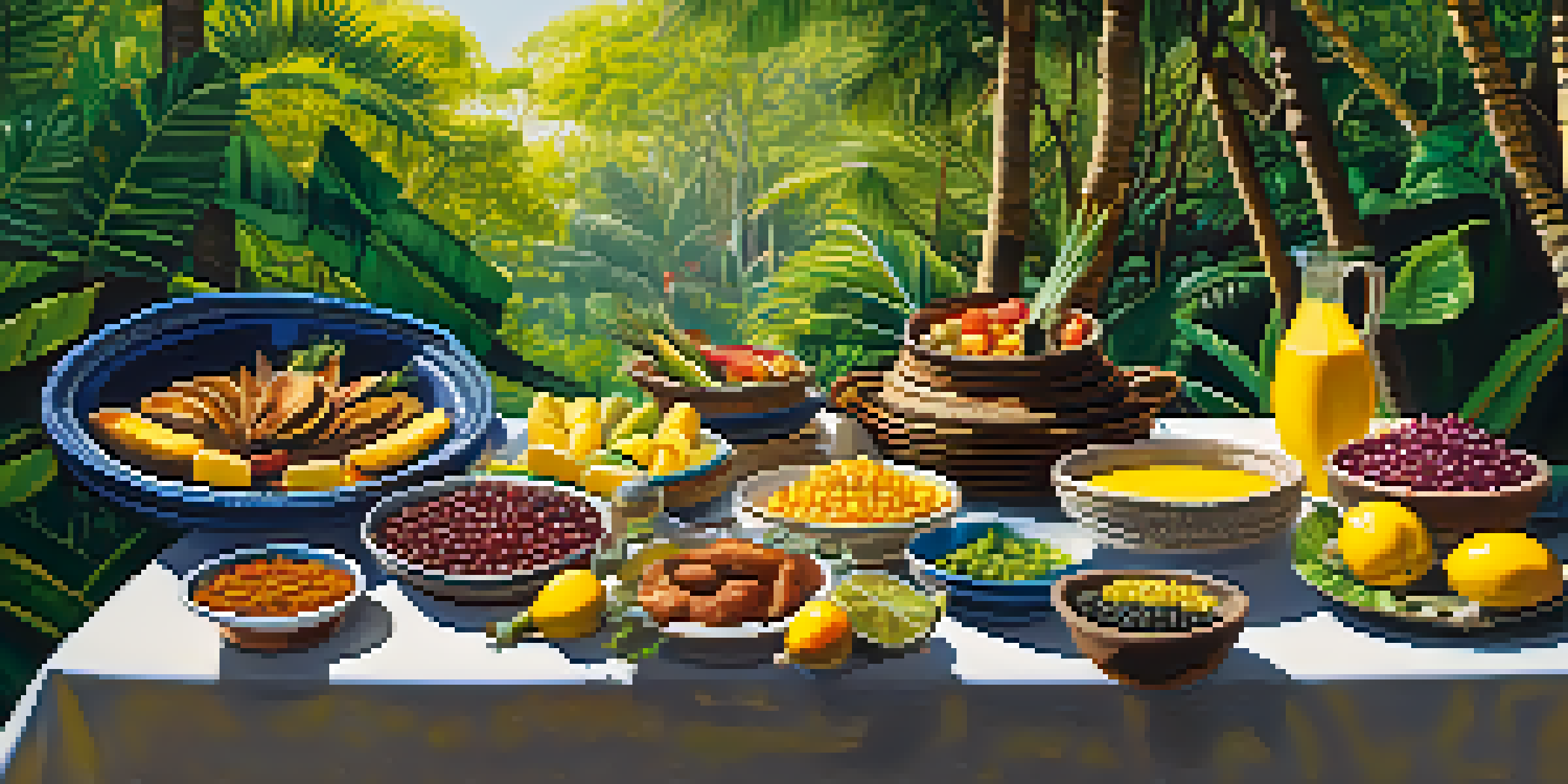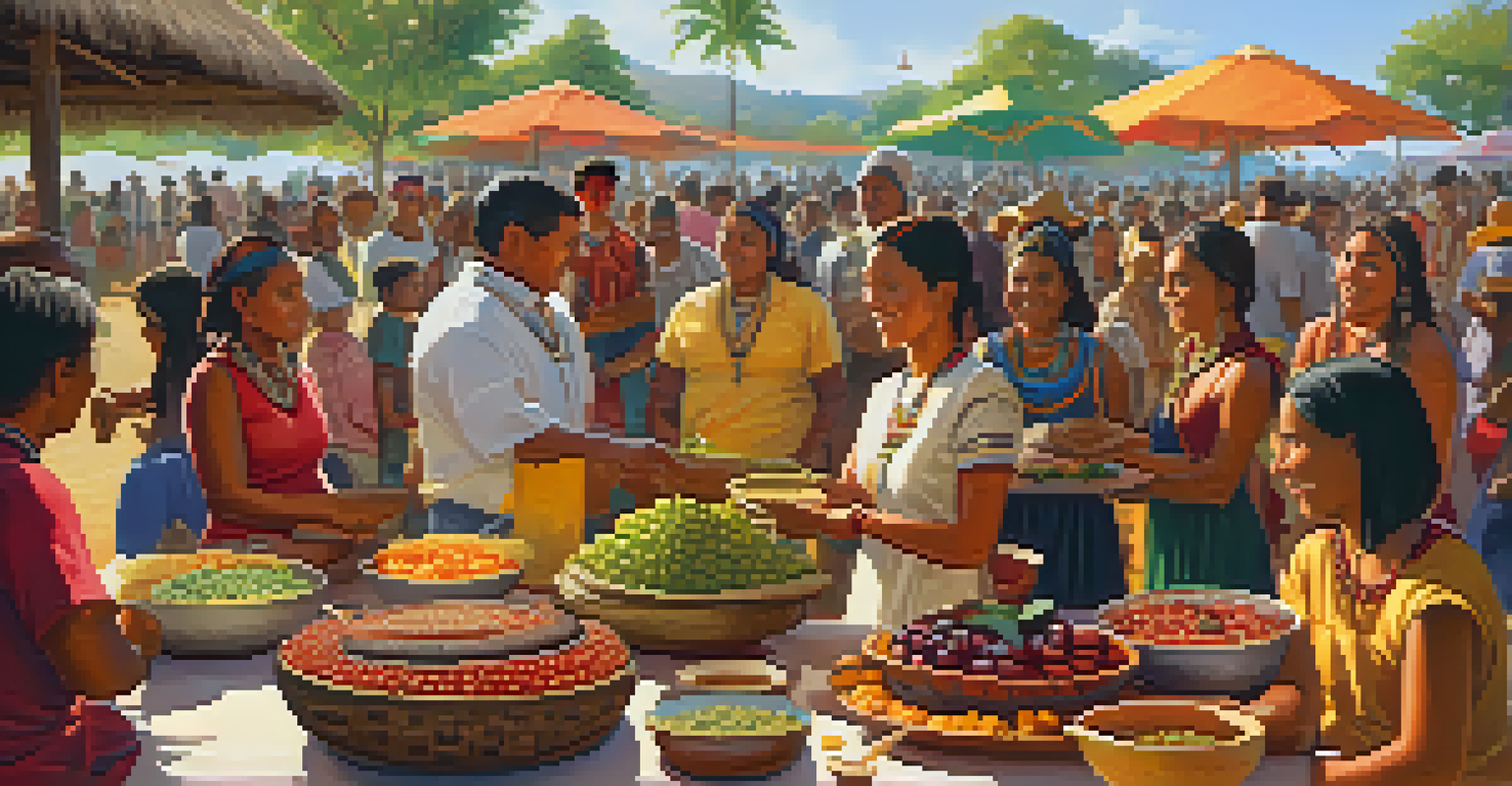Indigenous Gastronomy: Traditional Foods of Brazil

Understanding Indigenous Gastronomy in Brazil
Indigenous gastronomy in Brazil refers to the traditional food practices of the country's native peoples. This culinary heritage is deeply intertwined with their cultural identity, beliefs, and connection to the land. The vast biodiversity of Brazil offers a rich palette of ingredients that Indigenous communities have cultivated and perfected over centuries.
Food is our common ground, a universal experience.
Food is more than nourishment for these communities; it's a vital part of their social and spiritual lives. Traditional meals often reflect seasonal changes and local resources, highlighting the relationship between Indigenous peoples and their environment. By understanding this gastronomy, we gain insights into their worldviews and ways of life.
Moreover, Indigenous gastronomy emphasizes sustainability and respect for nature. Practices passed down through generations promote biodiversity and ecological balance, serving as a model for modern food systems that often overlook these values. This connection to the land is essential for understanding the significance of traditional foods.
Key Ingredients in Indigenous Brazilian Cuisine
The foundation of Indigenous cuisine is built on local and native ingredients, many of which are unique to Brazil. Staples like cassava (manioc), maize, and various fruits such as guava and açaí are commonly used in traditional dishes. Each ingredient carries its own story and significance, often linked to the region it comes from.

Cassava, for instance, is a versatile root that can be processed into flour, used in stews, or made into a popular beverage called 'tapioca.' The preparation methods are often labor-intensive, reflecting the community's dedication to preserving their culinary traditions. In many ways, these ingredients are a testament to the resilience and resourcefulness of Indigenous peoples.
Cultural Significance of Food
Indigenous gastronomy is deeply tied to cultural identity, beliefs, and the relationship with nature among Brazil's native peoples.
Additionally, the use of wild game and fish is prevalent, showcasing the hunters' skills and the importance of these foods in their diets. The combination of these ingredients creates flavors that are not only distinct but also deeply rooted in the cultural practices of the Indigenous peoples of Brazil.
Traditional Cooking Methods of Indigenous Peoples
Cooking methods in Indigenous Brazilian gastronomy are as diverse as the communities themselves. Techniques vary from roasting and boiling to more intricate methods like fermenting and smoking, all of which enhance the flavors and nutritional value of the dishes. These methods have been handed down through generations, preserving the essence of their culinary art.
The land is the source of life, and the food that comes from it is a gift to be shared and cherished.
One common method is the use of the 'curimã,' a traditional underground oven where food is wrapped in leaves and cooked with hot stones. This technique not only infuses the food with unique flavors but also embodies the communal spirit of sharing meals. Gathering around the 'curimã' becomes a social event, strengthening bonds within the community.
Furthermore, the emphasis on using fire and natural elements highlights the connection these communities have with their surroundings. Cooking is not just about preparing food; it reflects a deep respect for the land and the resources it provides. This holistic approach to cooking is a vital aspect of Indigenous gastronomy.
Significance of Rituals in Indigenous Food Practices
Rituals play a crucial role in the food practices of Indigenous communities in Brazil. Meals are often accompanied by ceremonies that honor the spirits of nature, ancestors, and the land. These rituals serve to reinforce cultural values and foster a sense of belonging among community members.
For instance, during harvest festivals, traditional foods are prepared and shared to celebrate the bounty of the land. Such gatherings are not only about food; they are a way to pass down stories, traditions, and teachings from one generation to the next. This connection to their heritage is essential for maintaining cultural identity.
Traditional Ingredients and Dishes
Key ingredients like cassava and traditional dishes such as 'pato no tucupi' reflect the unique flavors and stories of Indigenous Brazilian cuisine.
Additionally, certain dishes are reserved for specific occasions, further embedding food within the social fabric of Indigenous life. The preparation and consumption of these meals become acts of reverence, reminding the community of their history and the importance of their relationship with the earth.
Popular Traditional Dishes of Indigenous Brazil
When exploring Indigenous gastronomy, several traditional dishes stand out, each offering a unique taste of Brazil's culinary heritage. One popular dish is 'pato no tucupi,' which features duck cooked in a yellow sauce made from wild cassava. This dish is a celebration of local ingredients and showcases the complexity of flavors inherent in Indigenous cooking.
Another beloved dish is 'maniçoba,' a stew made with ground leaves from the manioc plant, often served with rice. This dish exemplifies the communal aspect of Indigenous meals, as it is typically prepared in large quantities for sharing amongst families and friends. The preparation of these dishes often involves elaborate processes, reflecting the dedication to preserving culinary traditions.
Moreover, the use of fruits like açaí in bowls or smoothies has gained popularity beyond Indigenous communities, highlighting the growing appreciation for these traditional foods. These dishes not only nourish the body but also connect individuals to the rich cultural tapestry of Brazil's Indigenous peoples.
The Role of Indigenous Gastronomy in Modern Brazil
Indigenous gastronomy is increasingly recognized in modern Brazil, as more chefs and food enthusiasts seek to celebrate and incorporate these traditional practices into contemporary cuisine. This resurgence not only honors Indigenous culture but also promotes biodiversity and sustainable food systems. It's a movement that encourages respect for the land and its original stewards.
Many restaurants now feature Indigenous-inspired dishes, raising awareness about the importance of preserving these culinary traditions. Chefs collaborate with Indigenous communities to source ingredients and learn traditional cooking methods, fostering a deeper appreciation for their heritage. This collaboration creates a bridge between past and present, enriching Brazil's culinary landscape.
Preservation of Culinary Heritage
Efforts are underway to revitalize Indigenous culinary traditions, ensuring they are passed down to future generations amidst challenges faced by these communities.
Furthermore, the spotlight on Indigenous gastronomy has sparked conversations about food sovereignty and the rights of Indigenous peoples. By elevating these traditional foods, we not only celebrate diversity but also advocate for the recognition and protection of Indigenous cultures and their contributions to society.
Preserving Indigenous Culinary Heritage for Future Generations
As we delve into Indigenous gastronomy, it's essential to consider the preservation of these culinary traditions for future generations. Many Indigenous communities face challenges such as land loss and cultural assimilation, threatening their food practices. However, there are ongoing efforts to document and revitalize these traditions, ensuring they are not lost to time.
Community initiatives, workshops, and educational programs are being developed to teach younger generations about their culinary heritage. By engaging youth in cooking and traditional practices, these programs foster pride in their culture and encourage them to carry on these traditions. The revival of interest in Indigenous foods is a promising sign for the future.

Moreover, promoting Indigenous gastronomy can benefit not only the communities themselves but also the broader society. By valuing and respecting these food traditions, we can cultivate a greater understanding of cultural diversity and the importance of sustainable practices. Protecting this culinary heritage is vital for the continued survival of Indigenous cultures in Brazil.